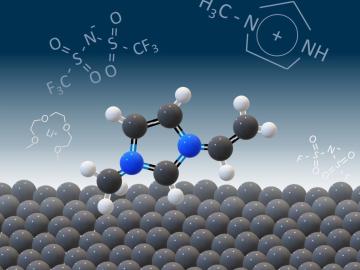
Filter News
Area of Research
- (-) Materials (87)
- (-) Materials for Computing (13)
- Advanced Manufacturing (2)
- Biology and Environment (50)
- Biology and Soft Matter (1)
- Computational Engineering (1)
- Computer Science (2)
- Electricity and Smart Grid (1)
- Energy Science (109)
- Energy Sciences (1)
- Fuel Cycle Science and Technology (1)
- Functional Materials for Energy (2)
- Fusion and Fission (32)
- Fusion Energy (10)
- Isotope Development and Production (1)
- Isotopes (6)
- Mathematics (1)
- National Security (19)
- Neutron Science (15)
- Nuclear Science and Technology (38)
- Nuclear Systems Modeling, Simulation and Validation (1)
- Quantum information Science (2)
- Sensors and Controls (1)
- Supercomputing (36)
News Topics
- (-) Energy Storage (38)
- (-) Microscopy (31)
- (-) Molten Salt (3)
- (-) Nuclear Energy (16)
- (-) Polymers (23)
- (-) Security (3)
- 3-D Printing/Advanced Manufacturing (27)
- Advanced Reactors (4)
- Artificial Intelligence (9)
- Big Data (2)
- Bioenergy (12)
- Biology (5)
- Biomedical (9)
- Buildings (5)
- Chemical Sciences (36)
- Clean Water (3)
- Composites (10)
- Computer Science (24)
- Coronavirus (7)
- Critical Materials (13)
- Cybersecurity (4)
- Environment (16)
- Exascale Computing (2)
- Frontier (3)
- Fusion (7)
- Grid (5)
- High-Performance Computing (4)
- Irradiation (1)
- Isotopes (14)
- ITER (1)
- Machine Learning (5)
- Materials (83)
- Materials Science (93)
- Mathematics (1)
- Nanotechnology (46)
- National Security (4)
- Neutron Science (38)
- Partnerships (11)
- Physics (28)
- Quantum Computing (4)
- Quantum Science (14)
- Simulation (2)
- Space Exploration (3)
- Summit (3)
- Transportation (19)
Media Contacts

A team led by Oak Ridge National Laboratory developed a novel, integrated approach to track energy-transporting ions within an ultra-thin material, which could unlock its energy storage potential leading toward faster charging, longer-lasting devices.

Real-time measurements captured by researchers at ORNL provide missing insight into chemical separations to recover cobalt, a critical raw material used to make batteries and magnets for modern technologies.

Scientists seeking ways to improve a battery’s ability to hold a charge longer, using advanced materials that are safe, stable and efficient, have determined that the materials themselves are only part of the solution.

Five researchers at the Department of Energy’s Oak Ridge National Laboratory have been named ORNL Corporate Fellows in recognition of significant career accomplishments and continued leadership in their scientific fields.

Oak Ridge National Laboratory scientists seeking the source of charge loss in lithium-ion batteries demonstrated that coupling a thin-film cathode with a solid electrolyte is a rapid way to determine the root cause.

Oak Ridge National Laboratory researchers have built a novel microscope that provides a “chemical lens” for viewing biological systems including cell membranes and biofilms.

In the search to create materials that can withstand extreme radiation, Yanwen Zhang, a researcher at the Department of Energy’s Oak Ridge National Laboratory, says that materials scientists must think outside the box.

Scientists at the Department of Energy Manufacturing Demonstration Facility at ORNL have their eyes on the prize: the Transformational Challenge Reactor, or TCR, a microreactor built using 3D printing and other new approaches that will be up and running by 2023.

Research by an international team led by Duke University and the Department of Energy’s Oak Ridge National Laboratory scientists could speed the way to safer rechargeable batteries for consumer electronics such as laptops and cellphones.

Oak Ridge National Laboratory researchers have developed a thin film, highly conductive solid-state electrolyte made of a polymer and ceramic-based composite for lithium metal batteries.


